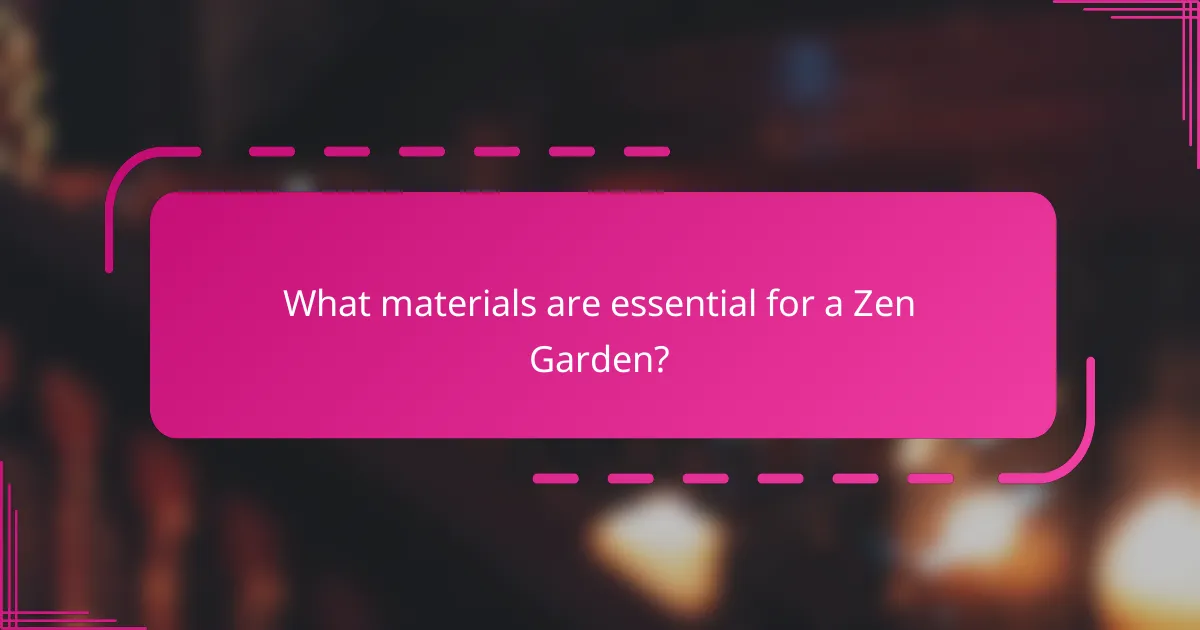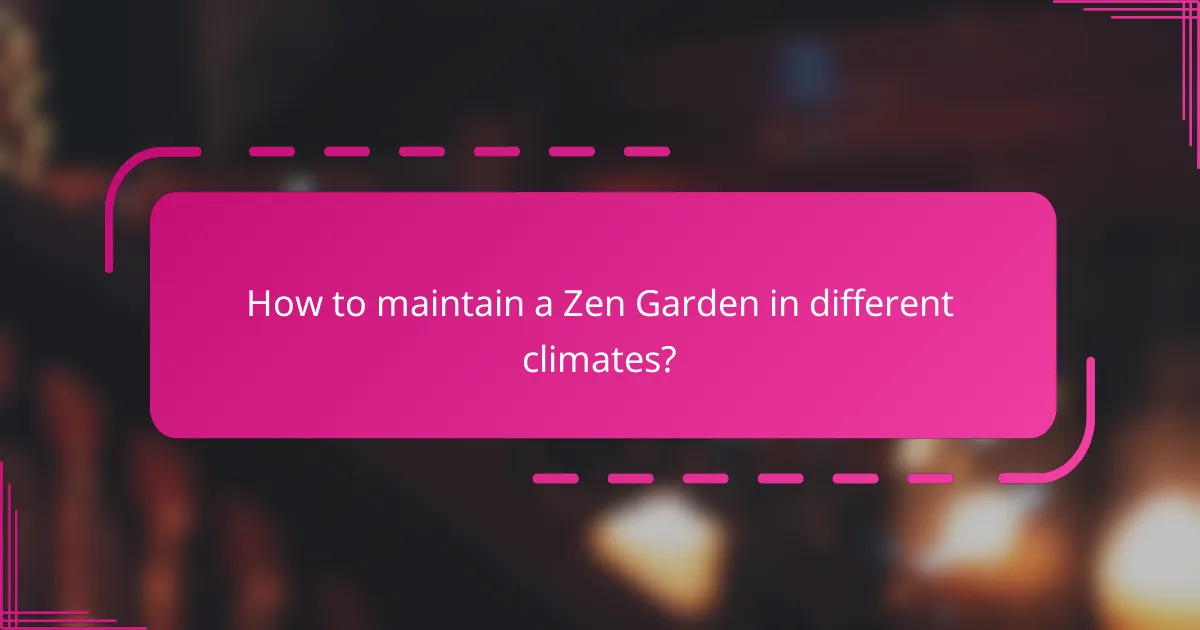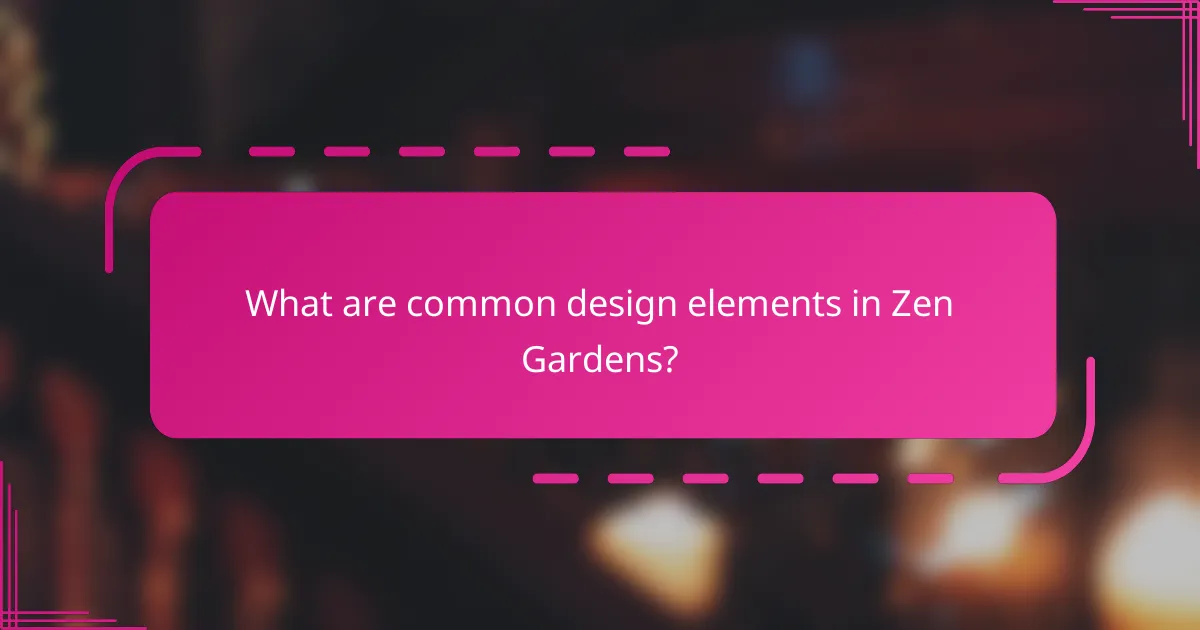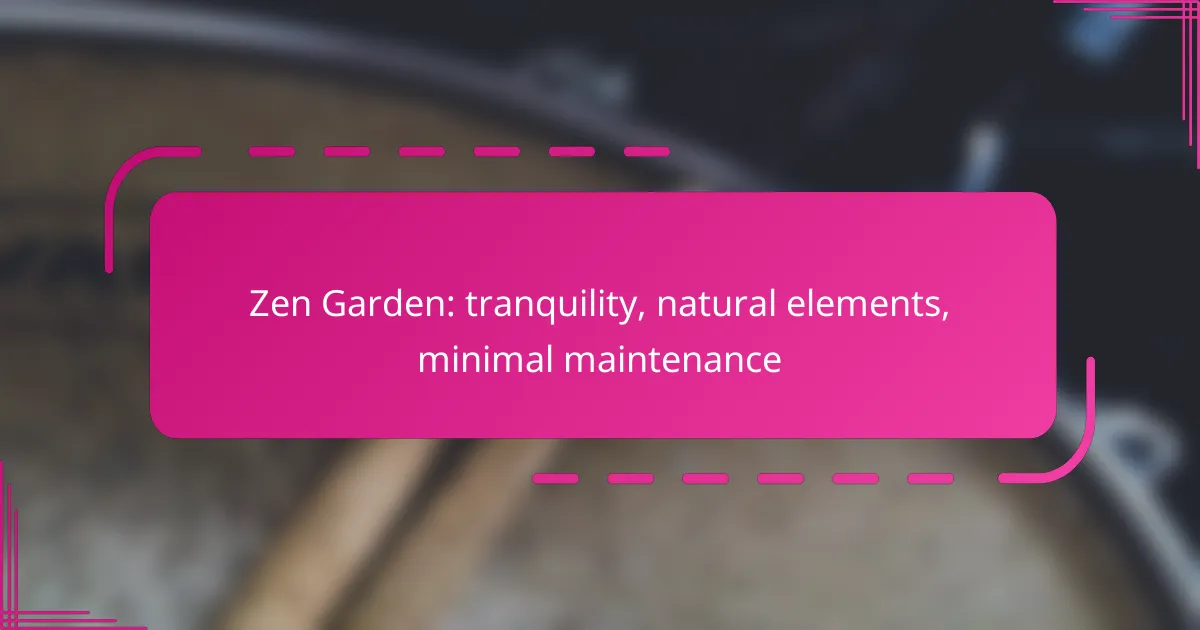A Zen garden is a serene retreat that combines natural elements to foster tranquility and mindfulness. By utilizing materials like gravel, sand, and native plants, these gardens require minimal maintenance while enhancing the beauty of any space. Ideal for urban environments, they offer a peaceful escape that encourages relaxation and reflection.

How to create a Zen Garden in urban areas?
Creating a Zen garden in urban areas involves using natural elements that promote tranquility while requiring minimal maintenance. Focus on incorporating gravel, sand, and native plants to design a serene space that fits within a compact environment.
Use gravel and sand for low maintenance
Gravel and sand are ideal materials for a low-maintenance Zen garden, as they require little upkeep compared to traditional lawns. Choose coarse gravel or fine sand to create a raked pattern that mimics water ripples, enhancing the calming effect of the garden.
To maintain the aesthetic, regularly remove debris and weeds. A layer of landscape fabric beneath the gravel can help prevent weed growth while allowing water drainage.
Incorporate native plants for sustainability
Using native plants in your Zen garden supports local biodiversity and reduces water usage. Select plants that thrive in your climate and soil conditions, as they will require less maintenance and are more resilient to pests.
Examples of suitable native plants include ornamental grasses, succulents, and flowering perennials. These plants not only enhance the garden’s beauty but also attract beneficial insects, contributing to a balanced ecosystem.
Design pathways for accessibility
Creating pathways in your Zen garden ensures accessibility and encourages exploration. Use materials like stepping stones, gravel, or wood chips to form clear, defined paths that guide visitors through the space.
Ensure pathways are wide enough for comfortable movement and consider incorporating seating areas along the way. This design allows for moments of reflection and enhances the overall tranquility of the garden.

What are the benefits of a Zen Garden?
A Zen garden offers numerous benefits, including promoting tranquility, enhancing property value, and requiring minimal maintenance. These gardens create serene spaces that encourage mindfulness and relaxation while being easy to care for, making them an appealing choice for homeowners.
Promotes relaxation and mindfulness
Zen gardens are designed to foster a sense of peace and contemplation. The simplicity of their layout, often featuring sand, rocks, and minimal vegetation, allows individuals to focus on the present moment, reducing stress and anxiety.
Engaging with a Zen garden can be a meditative practice. Raking the sand into patterns or arranging stones encourages mindfulness, helping to clear the mind and enhance emotional well-being.
Enhances property value
Incorporating a Zen garden can significantly boost the aesthetic appeal of a property, making it more attractive to potential buyers. A well-designed garden can create a unique selling point, distinguishing your home in a competitive market.
Investing in a Zen garden may yield a favorable return on investment, particularly in areas where outdoor living spaces are highly valued. Homeowners can expect an increase in property value by enhancing curb appeal and creating a tranquil retreat.
Requires minimal upkeep
One of the key advantages of a Zen garden is its low maintenance requirements. Unlike traditional gardens that may need regular watering, weeding, and pruning, Zen gardens primarily require occasional raking and the replacement of stones or gravel as needed.
To maintain a Zen garden effectively, focus on a few essential tasks: regularly rake the sand to keep patterns fresh, remove any debris, and check for erosion or displacement of stones. This minimal upkeep allows homeowners to enjoy the beauty of their garden without extensive labor.

What materials are essential for a Zen Garden?
Essential materials for a Zen garden include gravel or sand, rocks, and select plants. These elements work together to create a tranquil space that requires minimal maintenance while emphasizing natural beauty.
Gravel or sand as a base layer
Gravel or sand serves as the foundational layer of a Zen garden, providing a smooth surface that promotes a sense of calm. Typically, a depth of 2-4 inches is recommended, allowing for easy raking and maintenance.
Choose fine gravel or sand to create patterns that enhance the aesthetic appeal. Avoid larger stones, as they can disrupt the tranquility of the space and make maintenance more challenging.
Rocks for structure and aesthetics
Rocks are crucial for adding structure and visual interest to a Zen garden. They can represent mountains or islands, contributing to the overall theme of nature and balance.
Select a variety of sizes and shapes to create a natural look. Position larger rocks as focal points, while smaller stones can be used to define pathways or borders. Ensure that the arrangement feels organic and harmonious.
Plants for natural beauty
Incorporating plants into a Zen garden enhances its natural beauty and provides a sense of life. Choose low-maintenance species such as moss, succulents, or dwarf shrubs that thrive in your local climate.
Limit the number of plants to maintain a minimalist aesthetic. Aim for a balance between greenery and open space, allowing the garden’s design to promote tranquility and reflection.

How to maintain a Zen Garden in different climates?
Maintaining a Zen garden varies significantly based on climate, requiring adjustments in plant selection, maintenance routines, and weed management. Understanding your local environment is crucial for creating a tranquil space that thrives with minimal upkeep.
Adjust plant selection based on local climate
Selecting the right plants is essential for a Zen garden’s success in any climate. In warmer regions, consider drought-resistant plants like succulents or native grasses, while cooler climates may benefit from hardy perennials that can withstand frost.
Research local flora to find species that naturally thrive in your area, ensuring they require minimal maintenance. For instance, in Mediterranean climates, lavender and rosemary can add fragrance and beauty without excessive watering.
Regularly rake gravel for aesthetics
Raking gravel is a fundamental maintenance task that enhances the visual appeal of a Zen garden. Aim to rake the gravel weekly to maintain clean lines and patterns, which symbolize tranquility and order.
Use a lightweight rake with a long handle to make this task easier. Consider different raking patterns, such as straight lines or circular designs, to reflect your personal style while keeping the garden serene.
Manage weeds with natural methods
Weed management is crucial for preserving the peaceful atmosphere of a Zen garden. Employ natural methods such as hand-pulling or using organic mulch to suppress weed growth without chemicals that could disrupt the garden’s harmony.
Regularly inspect your garden for emerging weeds, especially during the growing season. A proactive approach will help maintain the aesthetic and prevent weeds from overshadowing the carefully selected plants.

What are common design elements in Zen Gardens?
Common design elements in Zen gardens include asymmetrical layouts, water features, and symbolic stone arrangements. These elements work together to create a tranquil environment that requires minimal maintenance while emphasizing natural beauty.
Asymmetrical layouts for balance
Asymmetrical layouts are fundamental in Zen gardens, promoting a sense of balance and harmony. By arranging elements in a non-linear fashion, the garden avoids rigidity and encourages a more organic feel. This design approach often utilizes uneven spacing and varying sizes of plants and stones to create visual interest.
When planning an asymmetrical layout, consider the placement of focal points, such as larger rocks or trees, to draw the eye naturally through the space. Aim for a balanced distribution of elements, ensuring that no single area feels overcrowded or neglected.
Water features for tranquility
Water features, such as ponds or small streams, are integral to enhancing the tranquility of a Zen garden. The sound of flowing water can evoke a sense of calm and serenity, making it a popular choice for relaxation spaces. Even a simple water basin can serve as a focal point while reflecting surrounding elements.
When incorporating water features, consider the scale and placement to maintain harmony with the overall design. Ensure that the feature is easy to maintain, as stagnant water can attract pests. A pump system can help keep the water fresh and flowing, enhancing the peaceful atmosphere.
Stone arrangements for symbolism
Stone arrangements play a crucial role in Zen gardens, often symbolizing mountains, islands, or other natural landscapes. The careful placement of stones can convey deeper meanings, such as strength and stability, while also serving as visual anchors within the garden. Each stone’s size and orientation can influence the overall aesthetic and feel of the space.
To effectively use stone arrangements, select stones that vary in size and texture, and arrange them in a way that feels intentional yet natural. Grouping stones in odd numbers is a common practice, as it tends to create a more dynamic and engaging composition. Regularly check for any disarray to maintain the intended symbolism and visual appeal.
